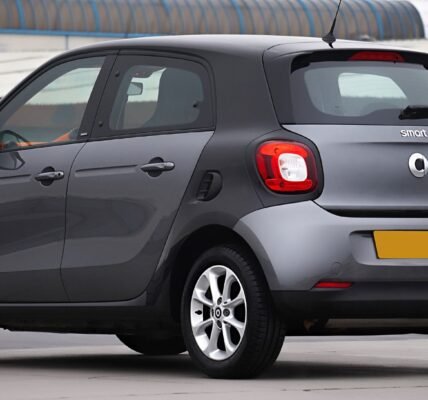The auto industry is evolving at lightning speed. Every year, we see breakthroughs in automotive innovation that redefine our driving experience. From electric vehicles to autonomous driving, the future of cars looks promising. But what are the latest trends shaping this transformation? Let’s explore the exciting breakthroughs in automotive innovation that are paving the way for the future.
The Rise of Electric Vehicles (EVs)
Electric vehicles are no longer a thing of the future; they are here, and they are thriving. The shift from gas-powered engines to electric vehicles marks one of the biggest breakthroughs in automotive innovation. EVs are eco-friendly, cost-effective, and efficient. This shift helps reduce carbon emissions and promotes sustainability.
Tesla, Rivian, and Nissan are leading the charge in the EV market. These brands are pushing boundaries with better range, faster charging, and sleek designs. The demand for EVs continues to rise, driven by incentives and environmental awareness. With advancements in battery technology, the future looks even brighter for electric cars.
Autonomous Driving: The Next Frontier
Autonomous driving represents another significant breakthrough in automotive innovation. Self-driving cars promise to make roads safer, reduce accidents, and enhance convenience. Companies like Waymo and Tesla are testing autonomous technology. They aim to bring fully self-driving cars to the market soon.
Autonomous cars use sensors, cameras, and AI to navigate. They can detect obstacles, follow traffic rules, and make real-time decisions. The dream of a hands-free driving experience is closer than ever. But regulatory hurdles and public trust remain challenges.
Smart Car Technology
Cars are getting smarter every day. The integration of AI and IoT is driving breakthroughs in automotive innovation. Today’s cars come equipped with smart technology that enhances the driving experience. This includes features like voice assistants, GPS navigation, and real-time diagnostics.
For example, you can now control your car with a smartphone app. You can check fuel levels, lock doors, or start the engine remotely. In-car entertainment systems are also becoming more advanced. Passengers can stream music, watch movies, or play games on the go.
Vehicle-to-Everything (V2X) Communication
The concept of Vehicle-to-Everything (V2X) communication is a game-changer. V2X allows cars to communicate with each other, as well as with infrastructure and pedestrians. This technology improves road safety and traffic management. It can prevent collisions, reduce congestion, and optimize fuel consumption.
Imagine your car getting alerts about accidents ahead or traffic light changes. V2X makes this possible. It’s one of the latest breakthroughs in automotive innovation that promises a safer driving experience.
Over-the-Air (OTA) Updates
Gone are the days of manual software updates at service centers. Thanks to over-the-air (OTA) updates, your car can stay up-to-date without leaving your garage. This technology allows manufacturers to push updates, fix bugs, and add new features remotely.
Tesla was a pioneer in using OTA updates. Now, other automakers are adopting this innovation. It ensures that cars stay current with the latest software enhancements. OTA updates are a key part of the breakthroughs in automotive innovation, offering convenience and cost savings.
The Push for Sustainable Materials
Sustainability is a top priority in today’s auto industry. Automakers are looking for eco-friendly alternatives to traditional materials. This trend is driving breakthroughs in automotive innovation. Companies are using recycled plastics, natural fibers, and sustainable leather in their car interiors.
For instance, BMW and Volvo are leading the way in using sustainable materials. These efforts reduce the carbon footprint of car production. The focus on sustainability extends to paint, tires, and even car batteries. The goal is to create vehicles that are both green and stylish.
Hydrogen Fuel Cell Technology
Electric vehicles are not the only solution for green transportation. Hydrogen fuel cell technology is another breakthrough in automotive innovation. Hydrogen cars produce zero emissions, only water vapor. They offer long-range driving and quick refueling times.
Toyota’s Mirai and Hyundai’s Nexo are examples of hydrogen-powered cars. This technology could complement electric vehicles, especially for long-distance travel. However, the lack of hydrogen refueling infrastructure remains a barrier.
Augmented Reality (AR) in Cars
Augmented Reality is finding its way into the automotive industry. This is one of the exciting breakthroughs in automotive innovation. AR enhances the driving experience by providing real-time data on the windshield. It can display navigation, speed, and road hazards right in your line of sight.
Brands like Mercedes-Benz and BMW are experimenting with AR technology. This feature enhances safety by reducing distractions. It allows drivers to keep their eyes on the road while accessing critical information.
Advanced Driver Assistance Systems (ADAS)
Advanced Driver Assistance Systems (ADAS) are making driving safer and easier. These systems use sensors and cameras to monitor road conditions. They include features like lane-keeping assist, adaptive cruise control, and automatic emergency braking.
ADAS represents a significant breakthrough in automotive innovation. It not only improves safety but also enhances driver comfort. More automakers are making ADAS a standard feature in new cars. This technology is a stepping stone toward fully autonomous driving.
The Future of Mobility: Shared and Connected
The future of cars goes beyond personal ownership. Shared mobility is gaining traction, driven by urbanization and environmental concerns. Car-sharing and ride-hailing services are part of the new mobility landscape.
Connectivity plays a crucial role in this trend. Cars can now connect to platforms that allow sharing rides, reducing the need for personal vehicles. This is another exciting area of breakthroughs in automotive innovation.
The Role of Artificial Intelligence (AI)
AI is at the heart of many breakthroughs in automotive innovation. It powers everything from self-driving cars to smart diagnostics. AI helps optimize fuel efficiency, enhance safety, and provide personalized driving experiences.
For example, AI can predict maintenance needs based on driving patterns. It can also optimize navigation to reduce travel time and fuel consumption. The possibilities are endless, and AI continues to drive innovation in the auto industry.
Conclusion
The future of driving is bright, thanks to breakthroughs in automotive innovation. From electric vehicles to autonomous technology, the auto industry is undergoing a massive transformation. These innovations are making cars safer, greener, and smarter.
As we look ahead, it’s clear that the breakthroughs in automotive innovation will continue to shape our driving experience. Whether it’s smarter connectivity, sustainable materials, or autonomous driving, the possibilities are endless. The road to the future is paved with innovation, and the journey has just begun.




